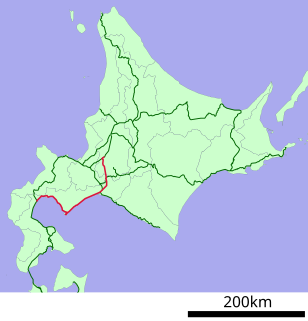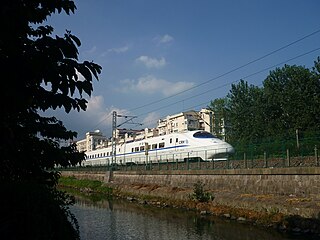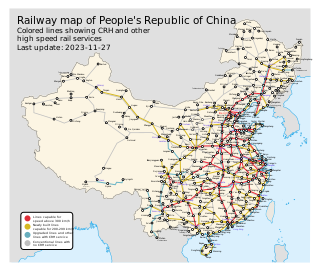
The Muroran Main Line is a railway line in Hokkaido operated by Hokkaido Railway Company, between Oshamambe Station in Oshamambe and Iwamizawa Station in Iwamizawa, approximately paralleling the coast of Iburi Subprefecture. There also is a branch line within Muroran, between Higashi-muroran and Muroran Station.
The history of rail transport in China began in the late nineteenth century during the Qing Dynasty. Since then, it has become one of the largest rail networks in the world.
Nanping–Fuzhou railway or Nanfu railway, is a railroad in eastern China between Nanping and Fuzhou in Fujian Province. The line is 186.7 km (116 mi) long and was built between 1956 and 1959.

The Xiaoshan–Ningbo railway or Xiaoyong railway, is a double-track railroad in eastern China between Hangzhou and Ningbo in Zhejiang Province. Its name in Chinese, the Xiaoyong Line, is named after the railway's two terminal stations, Xiaoshan, a suburban district of Hangzhou on the southern bank of Qiantang River, and Ningbo, whose Chinese character abbreviation is yong. The line is 147.3 km (92 mi) long and was originally built in three parts in 1912, 1914 and 1936 and then rebuilt in 1959 and electrified in 2009. Cities along route include Xiaoshan District of Hangzhou, Shaoxing, Shangyu, Yuyao and Ningbo, all in Zhejiang Province.

The Datong–Puzhou or Tongpu railway, is a major trunkline railroad in northern China, and the main axial railway of Shanxi Province. The railway is located entirely within Shanxi and diagonally bisects the province from Datong in the northeast to Fenglingdu, near the village of Puzhou, in the southwest corner. The line is named after Datong and Puzhou, and has a total length of 865 km (537 mi). The line is often referred to by its northern and southern halves with Taiyuan, the provincial capital as the midpoint. Southern Tongpu railway from Taiyuan to Fenglingdu is 513 km (319 mi) in length and was built from 1933 to 1935. The Northern Tongpu railway, from Datong to Taiyuan is 351 km (218 mi) in length and was built from 1933 to 1940. Major cities and towns along route include Datong, Huairen, Shuozhou, Ningwu, Yuanping, Xinzhou, Taiyuan, Yuci, Taigu, Qi County, Pingyao, Huozhou, Hongdong, Linfen, Houma and Fenglingdu.
The Handan–Changzhi railway or Hanchang railway, is a major railroad in northern China for the transportation of coal. The railway is named after its terminal cities, Handan in Hebei Province and Changzhi in Shanxi Province. The line is 221.7 km (138 mi) in length and was built from 1971 to 1983.
The Xinxiang–Yueshan railway or Xinyue railway, is a railroad in northern China between Yueshan Station of Bo'ai County and Xinxiang. The entire line, 79.8 km (50 mi) in length, is located in Henan Province and serves as a major conduit for the shipment of coal from Shanxi Province.
The Xinxiang–Yanzhou railway or Xinyan railway, is a railroad in northern China between Xinxiang in Henan Province and Yanzhou in Shandong Province. The line, 305 km (190 mi) in length and built in sections from 1911–1912, 1979–1980 and 1983–1985, serves as a major conduit for the shipment of coal from Shanxi Province. Major cities and towns along route include Xinxiang, Heze, Jining and Yanzhou.
The Yanzhou–Shijiusuo railway or Yanshi railway, is a railroad in northern China between Yanzhou and Shijiusuo Station in Rizhao. The entire line, 307.9 km (191 mi) in length, is located in Shandong Province and was built from 1981 to 1985. The Yanshi railway is a major conduit for the shipment of coal from Shanxi Province.
The Beijing–Chengde railway or Jingcheng railway, is a railroad in northern China between Beijing, the national capital, and Chengde in Hebei Province. The line is 256 km (159 mi) long and runs northwest from Beijing Municipality to Chengde in northern Hebei.

The Guizhou–Guangxi railway or Qian'gui railway, is a single-track electrified railroad in Southwest China between Guiyang in Guizhou Province and Liuzhou in Guangxi Zhuang Autonomous Region. The shorthand name for the line, Qiangui, is derived from the shorthand names of Guizhou and Guangxi.

The Guangzhou–Maoming railway or Guangmao railway, is a railroad in Guangdong Province of China between Guangzhou, the provincial capital, and Maoming. The line has a total length of 404.2 km (251 mi) and comprises the Guangzhou–Sanshui railway, built from 1902 to 1904, and the Sanshui-Maoming railway, built from 1958 to 1991. Major cities and towns along route include Guangzhou, Sanshui, Zhaoqing, Xinxing County, Yangchun, and Maoming.

The Litang–Zhanjiang railway or Lizhan railway, is a railroad in southern China from Litang Township in the Guangxi Autonomous Region on the Hunan–Guangxi railway, to the port city of Zhanjiang, in Guangdong Province, on the South China Sea. The line has a total length of 318.2 km (198 mi) and was built from 1954 to 1955. Major cities and towns along route include Guigang, Xingye County, Yulin (Guangxi), Luchuan, Lianjiang (Guangdong), Suixi (Guangdong) and Zhanjiang.
The Hechun–Maoming railway or Hemao railway, is a railroad in Guangdong Province, China, between Hechun Station on the Litang–Zhanjiang railway and the city of Maoming. The line has a total length of 61.56 km (38 mi) and was built from 1956 to 1959. The line was originally built to support the development of the petrochemical industry in Maoming. After the completion of the Sanshui–Maoming railway in 1991, the Hemao Line became a connecting section between the Litang–Zhanjiang and Guangzhou–Maoming railways. Together, the three railways form part of China's southern coastal railway corridor.

The Fengtai–Shacheng railway, also known as the Fengsha railway, is a dual-track, electrified, railroad in northern China. The Fengtai–Shacheng railway runs 105 km (65 mi) from Fengtai District in western Beijing Municipality to the town of Shacheng in Huailai County, Hebei Province. The line passes through Beijing's Fengtai, Shijingshan and Mentougou Districts, and Huailai County in northern Hebei. The original single track line was built from 1952 to 1955. The second track was added in 1972. The line was electrified in 1984.

Rail transport is an important mode of long-distance transportation in the People's Republic of China. As of 2015, the country has 121,000 km (75,186 mi) of railways, the second longest network in the world. By the end of 2018, China had 29,000 kilometres of high-speed rail (HSR), the longest HSR network in the world.[4]
The Shanxi–Henan–Shandong railway or the Jinyulu railway, also known as the Shanxi South Central railway or the Watang–Rizhao railway, is an electrified double-track heavy freight railway across northern China. The line runs 1,260 km (780 mi) from the village of Watang in Lüliang, Shanxi Province to the port of Rizhao in Shandong Province, and is named after the three provinces through which it passes Jin (Shanxi), Yu (Henan) and Lu (Shandong). The line is the world's longest heavy freight railway and is designed to facilitate the export of coal from Shanxi to overseas markets. The line can accommodate train speeds of up to 120 km/h (75 mph). Cities along route include Lüliang, Liulin, Hongdong, Changzhi and Pingshun in Shanxi; Linzhou, Anyang, Tangyin, Puyang, Hebi, Fan County and Taiqian County in Henan; Liangshan County, Dongping, Ningyang, Xintai, Laiwu, Yiyuan, Yishui, Ju County, Junan and Rizhao in Shandong. The line was built from 2010 to 2014 and operations began on December 30, 2014.












